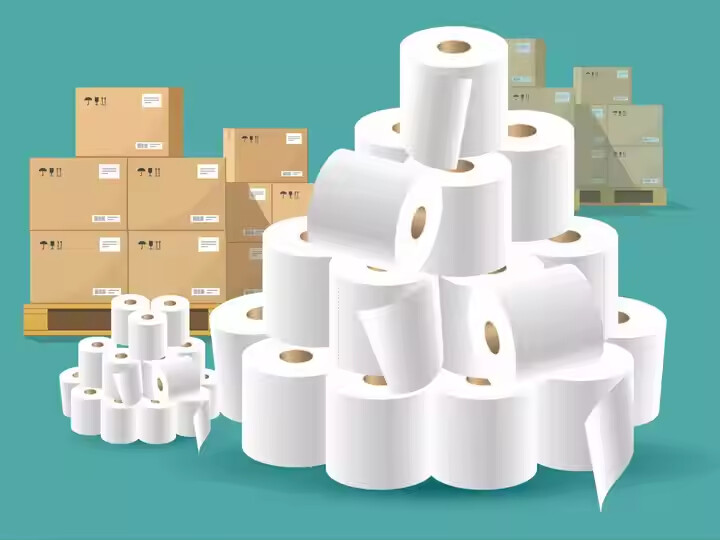News
Jolene

RELATED POSTS
MESSAGE

1. Classification by purpose (the most common way)
1. Toilet paper:
Core purpose: Toilet cleaning after going to the toilet.
Features:
▪Easy to decompose/disperse in water: This is the most important feature! In order to prevent clogging of the toilet pipe, qualified toilet paper (toilet paper) can be broken and dissolved quickly in water.
▪Moderate softness: Usually requires soft and comfortable touch.
▪No high strength requirement: Low wet strength to ensure easy decomposition.
Form: Roll paper is the most common, and there are also pull-out types.
Note: Never use other types of paper (such as facial tissue, kitchen paper) to replace toilet paper and flush it into the toilet, because they are not easy to decompose and can easily cause clogging.
2. Facial tissue:
Core purpose: Wipe the face, hands, blow your nose, etc.
Features:
▪High wet strength: It can still maintain a certain toughness and strength after being wetted, and is not easy to break or fall off. In this way, no paper scraps will be left on the face when wiping.
▪Soft and skin-friendly: It has higher requirements for skin touch and is usually more delicate and soft than toilet paper.
▪Add moisturizing factor: Some high-end facial tissues will add moisturizing ingredients (such as cream, aloe vera, glycerin) to reduce friction.
▪Not easy to decompose: This is the key difference from toilet paper! Facial tissue is not easy to decompose in water and cannot be flushed into the toilet.
Form: The most common boxed pull-out type, there are also small-packaged handkerchiefs.
Subdivision: Ordinary facial tissue, handkerchief (small package portable), moisturizing paper (containing cream, etc.), makeup remover paper, beauty towel, etc.
3. Kitchen paper:
Core use: Kitchen cleaning, oil absorption, water absorption, food wrapping, wiping kitchen utensils, etc.
Features:
▪Extremely absorbent: It can quickly absorb a large amount of liquid (water, oil).
▪High dry and wet strength: It is tough and not easy to break when dry, and it can maintain a certain strength for wiping after being wet.
▪Good toughness: It is suitable for wiping stains with force.
▪No fluorescent agent/fragrance is usually added: More attention is paid to food contact safety (but you still need to pay attention to whether it has food grade certification when purchasing).
▪Not easy to decompose: Cannot be flushed into the toilet.
Form: The most common roll type, there are also large pull-out types.
4. Wet wipes:
Core use: Use liquid cleaning ingredients for cleaning, disinfection, makeup removal, etc.
Features:
▪Composed of non-woven fabric + liquid (water, cleaning liquid, disinfectant, skin care liquid): The material is not "paper" (wood pulp paper) in the traditional sense, but non-woven fabric (may be made of wood pulp, chemical fiber, etc.).
▪Strong functionality: Depending on the added liquid, there are ordinary cleaning wipes, disinfecting wipes, baby wipes, feminine care wipes, makeup removal wipes, glasses wipes, household cleaning wipes, etc.
▪Convenient and ready to use: No water source is required.
▪ Difficult to decompose/prominent environmental issues: Most wet wipes (especially those containing chemical fiber non-woven fabrics) are extremely difficult to decompose and must not be flushed down the toilet (one of the culprits causing sewer blockages and "Fatberg"), and are prone to plastic pollution to the environment (especially the ocean). Some brands have launched flushable wet wipes, but their environmental friendliness and actual decomposition effect are still controversial.
Form: Individually packaged or boxed/barreled pull-out.
5. Female hygiene products:
Core use: Female menstrual care.
Products: Sanitary napkins (daily, night, panty liners), tampons, etc.
Material: The surface layer is usually a dry mesh or cotton non-woven fabric, the absorbent layer is fluff pulp and polymer absorbent resin (SAP), and the bottom layer is a leak-proof film.
Treatment: It belongs to other garbage/non-recyclable garbage and cannot be flushed down the toilet.
???? 2. Classification by material/raw material
1. Virgin wood pulp paper:
Made of pure wood pulp extracted directly from wood and not used.
Advantages: Usually purer, softer, sanitary (less impurities), relatively strong.
Disadvantages: Consumes forest resources and has a high cost.
Commonly used in: mid-to-high-end toilet paper, facial tissue, kitchen paper.
2. Pure wood pulp paper:
This term is somewhat vague. Strictly speaking, it refers to pulp that is 100% from wood, but may include virgin pulp and recycled pulp. Many manufacturers use "pure wood pulp" to imply virgin pulp, but in fact it may be mixed with recycled pulp. Pay attention to specific instructions or brand reputation when purchasing.
Advantages: May be lower cost.
Disadvantages: The quality and purity may not be as good as products clearly marked as "virgin wood pulp".
3. Bamboo pulp paper:
The main raw material is bamboo fiber.
Advantages: Bamboo grows fast, is highly renewable, and is relatively more environmentally friendly. Some products have natural antibacterial properties. It may feel more flexible.
Disadvantages: The maturity of the production process and the stability of quality may not be as good as wood pulp paper. Some bamboo pulp papers may have added wood pulp.
4. Straw pulp paper/mixed pulp paper:
The raw materials include non-wood fibers, such as reeds, wheat straw, bagasse (sugarcane pulp), etc., or mixed with wood pulp.
Advantages: Using agricultural by-products, the cost is low.
Disadvantages: The fibers are shorter, the paper is usually rougher, not soft enough, the strength is low, and it is easy to lose powder and hair. Commonly found in low-end toilet paper.
Note: Pure straw pulp paper is not suitable for facial tissue or kitchen paper.
5. Recycled paper/recycled paper:
Pulp made from recycled waste paper (such as office paper, cardboard boxes) after deinking, bleaching and other treatments.
Advantages: Environmental protection, saving resources, and reducing landfill.
Disadvantages: The fibers become shorter after multiple treatments, and the paper is usually rougher, grayer in color (even if bleached), and has lower strength. It may contain trace amounts of ink residue (must meet safety standards).
Commonly found in: Some environmentally friendly brands of toilet paper, kitchen paper, or low-end toilet paper. Not suitable for facial tissue (contact with the face) and kitchen paper that comes in direct contact with food.
6. Non-woven fabric:
Mainly used for wet wipes. It is not "paper" in the traditional sense, but a sheet made by directly bonding or entangled fibers (wood pulp, viscose, polyester, polypropylene, etc.) by physical, chemical or thermal methods.
Features: Non-woven, with various production processes, can give different strength, feel, and water absorption. Chemical fiber non-woven fabrics are the main reason why wet wipes are difficult to decompose.
Please give us a message
Please give us a message
